Is it true that internal drives of smartphones are better than any memory card, and when will microSD be retired?
Hi, Giktayms! In recent years, manufacturers of gadgets believe that a good smartphone is a monolithic smartphone. Accumulators have ceased to be removable, the usual SIM-cards, in their classical sense, can also sink into oblivion, and instead of the good old microSD, manufacturers are actively “pedaling” the development of drives built into smartphones. Are gigabytes so “nailed up with nails” so fast, profitable and reliable, or is it just a new round on the way to “one-off” gadgets?

Memory cards side by side with smart phones since the “prehistoric” time. The world's first smartphone, IBM Simon , was content with 1 MB on the internal drive back in 1994, but supported connection of drives up to 1.8 MB using the PCMCIA interface. And the Nokia 9000 Communicator, which appeared two years later, could also boast an MMC slot.
After that, years on end, the MMC / RS-MMC / Memory Stick / SD / miniSD / microSD slot became a constant companion of mobile phones. The only exceptions were models with a huge, monstrous memory that stood out from the competition, like the current mobile phones with 256 GB on board, next to the usuallaundry detergent smartphone.
')
We have already spoken about the wonderful excuses of manufacturers who have amputated the microSD slot in smartphones and the “basement” method of increasing memory, and today we have to figure out whether the internal drive is more than a flash drive inside out, and what it is in comparison with microSD of the same release period.
The refusal of removable drives in smartphones, we will not be cunning, provoked the iPhone in 2007, and the technical implementation for device manufacturers “pulled up” from the JEDEC standardization committee in the form of eMMC modules.
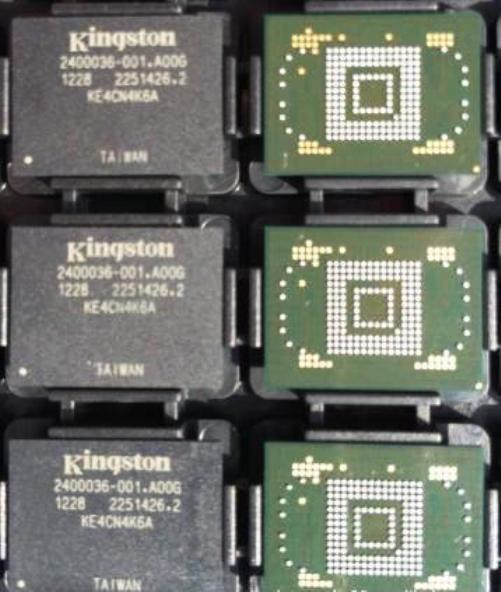
Spherical eMMC chip in package: Kingston KE4CN2H5A, 4 GB, 153-Pin, BGA
What is eMMC ? Integrated Multimedia Card (Embedded Multimedia Card). Developed for mobile phones, tablets, navigators, car multimedia systems and other consumer electronics. The debut of eMMC chips came in 2008 and coincided with the period when electronics manufacturers made their decision in the so-called “battle of formats”. For the attention of vendors fought two variants of the memory subsystem in mobile devices:
• NOR flash memory for storage and SRAM / PSRAM in the role of RAM. For such a combination were Intel and Spansion (now Cypress Semiconductor). The drive in this design was a MCP-chip, this type of design was most common in the era of push-button smartphones.
The “old school” combination was nice to gadget makers with moderate power consumption and better performance in data reading operations.
• NAND -flash memory and SDRAM RAM was a newfangled design, spread by a huge alliance, in which the main ideologues were Samsung and Toshiba. This combination of components negatively affected the autonomy of mobile devices, but the performance of RAM and low cost (already then) NAND did their job - mobile phones needed their own drives not only for service needs, and NAND already cost vendors one third of its introduction to gadgets cheaper than nor.

How eMMC works compared to typical flash drives
The most widely used is the second option, so the typical eMMC drive was a NAND-based chip + an integrated controller with error correction support (ECC). Thus, mobile technology manufacturers have acquired a capacious and inexpensive implementation of the memory subsystem, bypassing clumsy (as for phones) hard drives.
Was this progress noticeable by simple users? Only when it came to flagship models - eMMC was launched as a type of MMC 4.3 implementation in 2008 , when DRAM became the usual RAM in the flagships, and 16 GB on the internal drive was an incredible luxury. For example, the iPhone 3GS with 16 GB on board at the same time cost 27,000 rubles, and the basic version with 8 GB - 23 thousand. No one is surprised that the flagship smartphone, taking into account inflation, cost about 60 thousand rubles, it is unlikely that anyone will be surprised. But the extra charge for 8 GB of memory in terms of the reality of 2017 was equivalent to ~ 8500 rubles.
In a word, the integrated universal (and not only for settings, registry of applications and phone book) memory in smartphones was still frantically expensive, but could already boast an impressive volume at the turn of 2009-2010. Do not forget that before shooting video in Full HD in popular smartphones there was still a lot of time, and in 2009 the Nokia N97 was born with an astounding 32 GB of internal memory costing all the same 27 thousand rubles at the start of sales.
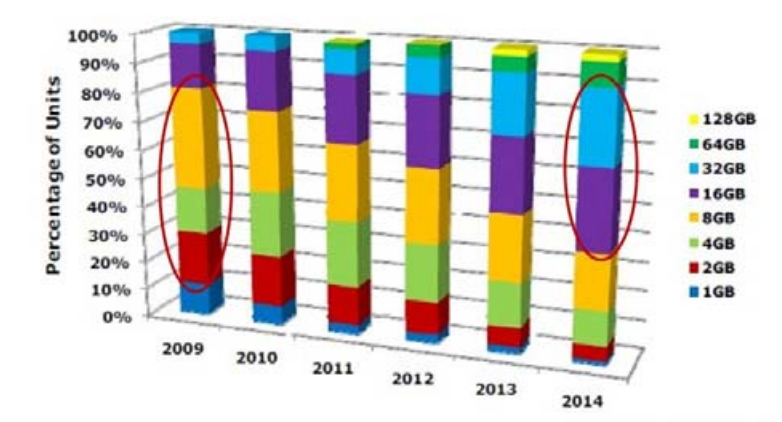
The eMMC capacity in smartphones did not increase as much as we would like (source: Micron Marketing)
And yet the memory cards of the same period were much cheaper. Even with the fact that microSDHC was a new standard, and sales accounted for most often on Class 4 cards.
On the side of the integrated memory, in theory, there was a higher performance in linear read and write operations, and the newest standard eMMC 4.41 of the 2010 sample allowed for a “ceiling” of bandwidth up to 100 MB / s, writing speed up to 30 MB / s. Needless to say that:
1. In real-world work scenarios, the speed was incomparably lower
2. The hardware platform of smartphones of 2010 model year could not realize the full potential of eMMC 4.1
3. The vast majority of smartphones were satisfied with 4-8 GB of internal memory
At the same time, memory cards of classes 4 and 6 were able to work even faster than the controller built into smartphones, video recording with a bitrate of over 50 Mbit / s on mobile phones was exotic, and the speed of applications, like in the case of SSD, did not depend from peak linear speeds, and from performance in working with tiny files in volume to megabytes.
Since 2010, drives integrated into smartphones have evolved evolvingly - JEDEC has “polished” the MMC 4.x standard over and over, the typical amount of internal memory by 2014 has grown to 8/16 GB, and smartphones without a memory card slot were rare: either iPhone , either Google Nexus, or the Chinese flagship Meizu / Xiaomi with a similar ideology in relation to the drives.
In the future, JEDEC was slowly developing eMMC: if you do not take into account the evolution of NAND-flash, it was to implement and refine SecureTRIM, and also the drives were taught to interact with new types of DDR memory. The eMMC performance increased to a peak of 260 MB / s over the bus and 50 MB / s for “jump” recording, in linear operations. And, although the systems on the chip in smartphones were still too slow to “squeeze all the juices” out of such memory, the integrated drives finally matured to work with another class of devices — Windows tablets.
The eMMC 4.5 standard has been installed on this since 2013, when smartphones began to try on memory modules with a capacity of 64 GB.
What could a microSDXC memory card offer in a similar era? For example, a new performance standard Class 10 UHS-I with data transfer up to 104 MB / s (~ 50 MB / s for reading and ~ 40 MB / s for recording in real conditions during linear operations), up to 2000 IOPS in read mode. That is, the video stream even with the most impressive bitrate fit into the speed of memory cards with a margin. But the launch of executable files from the memory card in smartphones in 2013, alas, won over eMMC - starting with Android 4.4 KitKat, Google “tightened” the nuts and restricted access of applications to the memory card until the “vanilla” version of the operating system was closed access even to write cache of giant 3D games.

Android we lost. Well, at least his memory management
With the debut of eMMC 5.0, the integrated memory of smartphones made a giant leap in performance, but it was replaced by a new and, according to test results, a more promising standard of integrated drives.
In later revisions of eMMC (5.0 in 2013 and 5.1 in 2015), JEDEC for some reason did not just “inflate” the linear read and write speed, but also implemented a multi-stream command processing protocol - delays in operations with random access to information became lower . Also, there was a collection of statistics on the health of the drives (before that there was simply no truly intelligent diagnostic system in eMMC), the function of safe sleep care and the ability to update the firmware on a working device (useful in industrial-grade devices).
And yet the debut of the UFS standard has become a much louder event. Its development began in 2011 , but developed it “in agony”, so only devices based on the late (2013) versions of UFS 2.0 and 2.1 were distributed. In particular, the drive standard UFS 2.0 and LPDDR4 memory for the first time got a Samsung Galaxy S6 smartphone. The Korean manufacturer even took a risk and refused to slot for microSD, in order to draw the attention of buyers to the speed of a new type of memory. As practice has shown, such a move was erroneous, so in the new generation Galaxy S, Samsung returned the ability to install memory cards.

UFS memory cards will replace microSD ... probably
For many reasons, UFS looks like the most likely successor to the modern varieties of the Embedded Multimedia Card:
• serial interface (UFS) is much preferable to parallel (eMMC) in terms of performance
• idle power consumption is almost 2 times lower than in options based on MMC
• the ability to develop memory cards and seamless integration with the internal storage of smartphones
• effective swap in the case when the RAM of the mobile device is crammed
Today, Samsung, Nokia, Texas Instruments, STMicroelectronics and Micron Technology are advocating the introduction of a new memory standard. But to realize a new standard in serial devices is an expensive pleasure, especially since there is no talk of backwards compatibility with microSD.
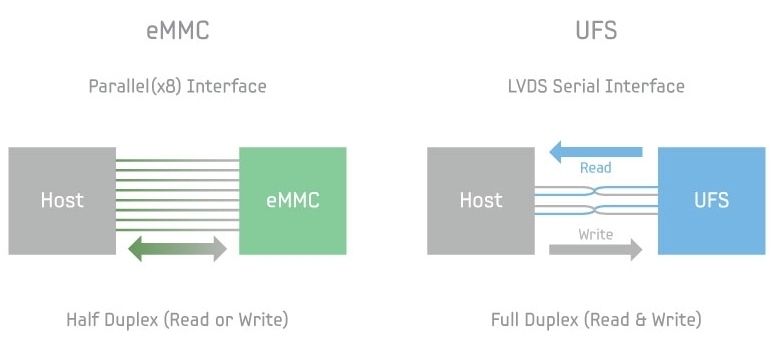
The second generation of UFS drives was supposed to turn the drive market in mobile technology, but its implementation was postponed indefinitely
Most manufacturers adhere to conservative views and prefer the more common, albeit less productive, version with eMMC 5.1. Before 2018, it is hardly worth expecting serial devices with removable drives of the UFS standard.
Is there a manufacturer with a third point of view in this situation? There is, and you will guess from one time who strives, so to speak, “Think different” despite all competitors.
If Samsung "reinvents" the improved version of MMC, and conservative manufacturers answer "we will fight with the old one!", Then Apple, in fact, stands for integrating the usual SSD memory into our smartphone using the custom implementation of PCI-e and NVMe protocol !
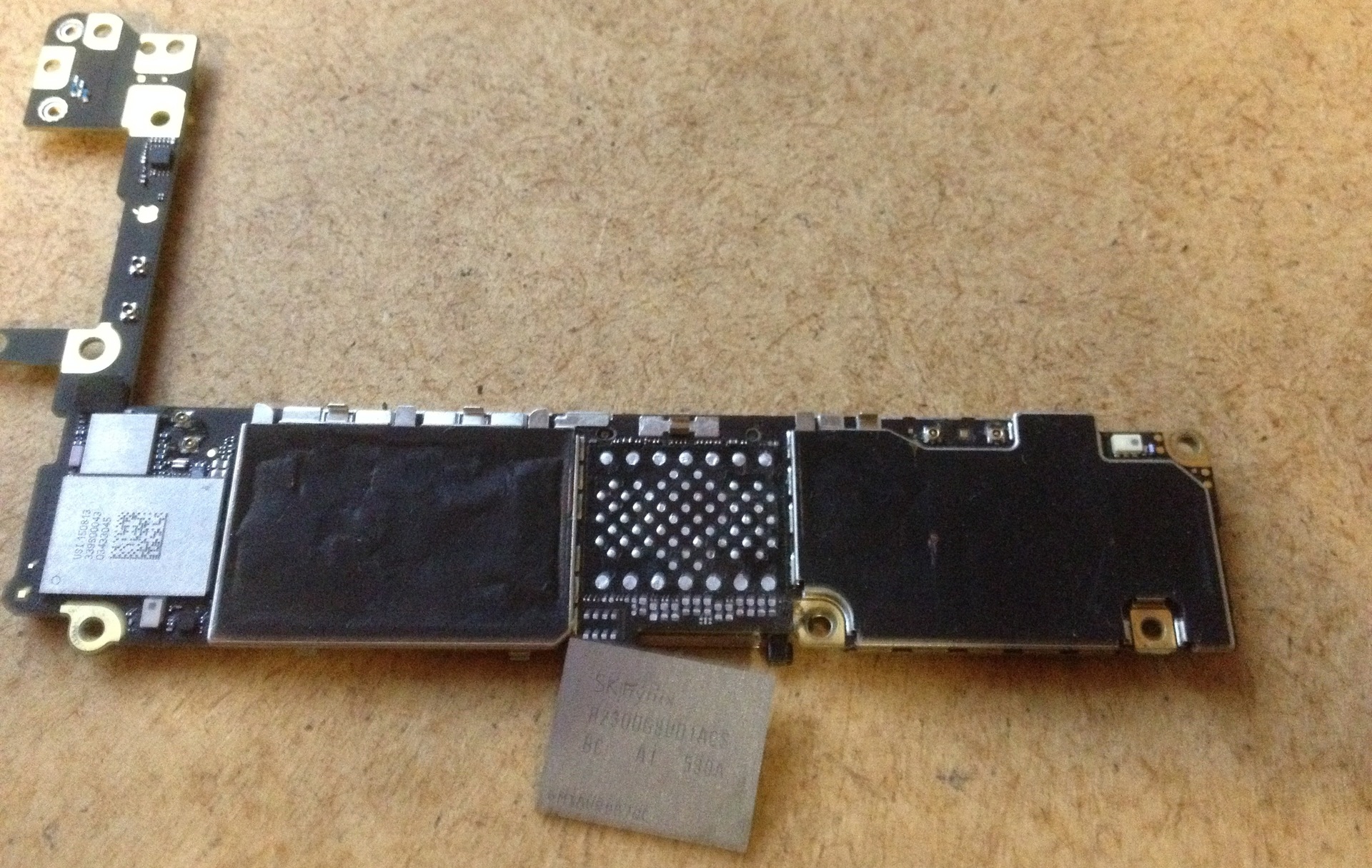
Enthusiast has developed a driver and card reader for NVMe chips from iPhone 6s (Caution! All rights reserved, and the like )
To say that Apple installed an SSD in a smartphone would be too loud a statement (after all, an atypical implementation of solid-state drives inside the iPhone), but among all the common types of drives in mobile phones, this one is closest to what we see in PCs and laptops.
For the first time, Apple used such a drive in the iPhone 6s and 6s Plus without much PR of this approach, so the gap of about 35-37% compared to UFS 2.0 and one of the fastest Samsung Galaxy S6 in terms of memory was almost sensational.


The drive running NVM Express in the iPhone 6s set the heat for competitors in consecutive reading and writing (source: Anandtech.com )
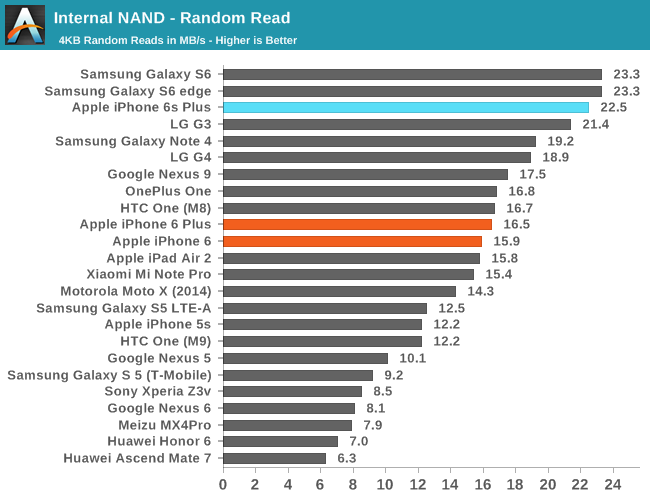
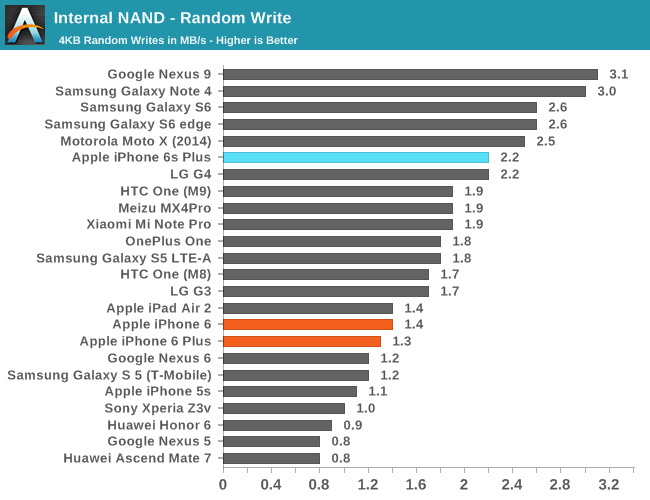
... although it did not shine in random operations
But nobody wrote about it, right? Therefore, you will laugh, but Samsung did not upgrade the built-in memory in the Galaxy S7, but the Apple found the revolution in the iPhone 6s to be sufficient, so from the point of view of speed, and now there is an iPhone with its “micro-SSD” second year in a row remains a smartphone with the fastest memory subsystem.
Solid numbers in successive operations on smartphone drives are pleasing to the eye, but in reality the mobile phone user has no place to take and start downloading / uploading data at gigabit speed.
Much more important is the response time, the launch speed of compact applications, reliability (so as not to “oh, hang, you need to wait) and speed characteristics, which are enough to record super-sharp video in modern cameras. For such tasks today, microSD memory cards of the UHS-I Speed Class 3 standard are being designed. For example, Kingston SDCA3 memory cards will not “choke” even in streaming video recording at a bitrate over 500 Mbit / s, and there are dozens of pieces to stamp photos in RAW. In smartphones, the card’s high-speed potential is sufficient with an impressive margin - the drive is truly “hardcore”.
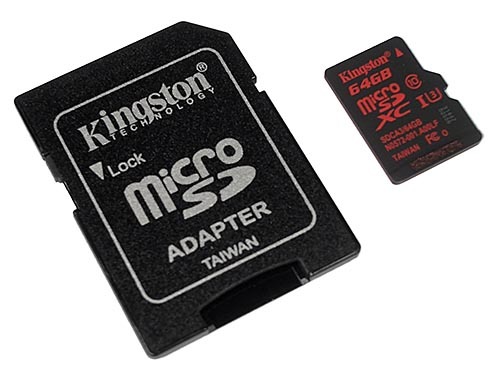
Kingston SDCA3 - the newest memory card standard UHS-I Speed Class 3
Slightly less aggressive in terms of speed, but also a modern model - the Kingston Gold UHS-I Speed Class 3 SDCG card. Her main superpower is to be fast enough to record 4K video and save information in situations where “oh, my camera / smartphone seems to be everything.” The Kingston Gold Series is not as fast under extreme load as the SDCA3, but even it is 4.5 times faster than Class 10 memory cards.

Kingston Gold UHS-I Speed Class 3 - a fast-acting, fast-acting card for 4K video recording
In an ideal world that Apple and Google like to talk about, the owner of the smartphone travels between Wi-Fi access points at impeccable speed and through the territory with an unusually high quality, not overloaded LTE-Advanced connection. Moreover, it does this with an unlimited data plan ( ha-ha-ha! ), By means of which 4K-video, Full HD movies and gigabytes of games are evenly spread across 64 GB or less of storage devices. The reality is so more prosaic that it’s better not to paint it in detail - the dreamers will be upset.
Do not forget that the mobile systems on the chip went to the technical process of 10 nm FinFET, which means that the further development of the technology will take a painfully long time. That is, processors in smartphones will develop less intensively, as it already happens in desktops. And, if smartphone buyers change their models to new models less often, the drives will become a bottleneck for owners of smartphones without a microSD slot.
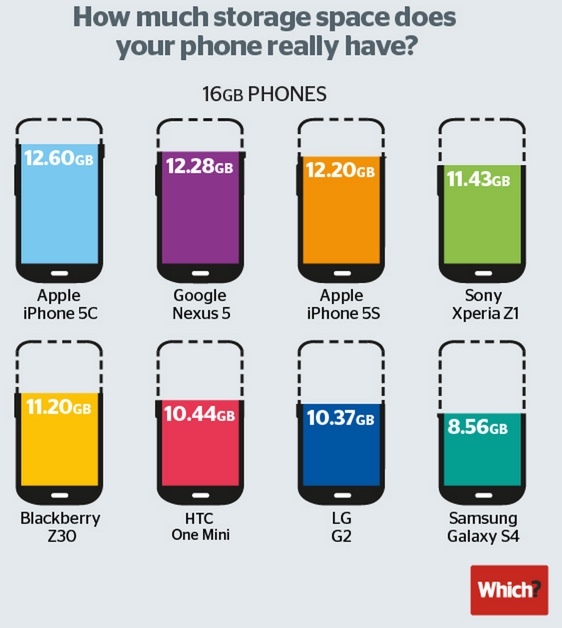
You see the capacity of 16 GB - do not trust your eyes (source: ZDNet.com )
And still, buying a high-capacity memory card is still more profitable than a couple of years of paying for cloud storage (access to which requires the appropriate quality of the Internet). Moreover, the reliability of modern "flash drives" will help to save all the necessary data when the smartphone died and did not have time to synchronize with the online drive.
May there always be an effective “plan B” in your life, even in the most unpleasant situations, and the data dear to your heart are never lost! After all, only they and our dear people capture the details of everyday life, which we will warmly recall decades later.
Subscribe and stay with us - it will be interesting!
For more information about Kingston and HyperX products, visit the company's official website . In choosing your kit HyperX help page with visual aids .

Memory cards side by side with smart phones since the “prehistoric” time. The world's first smartphone, IBM Simon , was content with 1 MB on the internal drive back in 1994, but supported connection of drives up to 1.8 MB using the PCMCIA interface. And the Nokia 9000 Communicator, which appeared two years later, could also boast an MMC slot.
After that, years on end, the MMC / RS-MMC / Memory Stick / SD / miniSD / microSD slot became a constant companion of mobile phones. The only exceptions were models with a huge, monstrous memory that stood out from the competition, like the current mobile phones with 256 GB on board, next to the usual
')
We have already spoken about the wonderful excuses of manufacturers who have amputated the microSD slot in smartphones and the “basement” method of increasing memory, and today we have to figure out whether the internal drive is more than a flash drive inside out, and what it is in comparison with microSD of the same release period.
eMMC - integrated "flash drive" in multimedia mobile phones
The refusal of removable drives in smartphones, we will not be cunning, provoked the iPhone in 2007, and the technical implementation for device manufacturers “pulled up” from the JEDEC standardization committee in the form of eMMC modules.

Spherical eMMC chip in package: Kingston KE4CN2H5A, 4 GB, 153-Pin, BGA
What is eMMC ? Integrated Multimedia Card (Embedded Multimedia Card). Developed for mobile phones, tablets, navigators, car multimedia systems and other consumer electronics. The debut of eMMC chips came in 2008 and coincided with the period when electronics manufacturers made their decision in the so-called “battle of formats”. For the attention of vendors fought two variants of the memory subsystem in mobile devices:
• NOR flash memory for storage and SRAM / PSRAM in the role of RAM. For such a combination were Intel and Spansion (now Cypress Semiconductor). The drive in this design was a MCP-chip, this type of design was most common in the era of push-button smartphones.
The “old school” combination was nice to gadget makers with moderate power consumption and better performance in data reading operations.
• NAND -flash memory and SDRAM RAM was a newfangled design, spread by a huge alliance, in which the main ideologues were Samsung and Toshiba. This combination of components negatively affected the autonomy of mobile devices, but the performance of RAM and low cost (already then) NAND did their job - mobile phones needed their own drives not only for service needs, and NAND already cost vendors one third of its introduction to gadgets cheaper than nor.

How eMMC works compared to typical flash drives
The most widely used is the second option, so the typical eMMC drive was a NAND-based chip + an integrated controller with error correction support (ECC). Thus, mobile technology manufacturers have acquired a capacious and inexpensive implementation of the memory subsystem, bypassing clumsy (as for phones) hard drives.
2008 Scientists have found that there can be a lot of memory in smartphones.
Was this progress noticeable by simple users? Only when it came to flagship models - eMMC was launched as a type of MMC 4.3 implementation in 2008 , when DRAM became the usual RAM in the flagships, and 16 GB on the internal drive was an incredible luxury. For example, the iPhone 3GS with 16 GB on board at the same time cost 27,000 rubles, and the basic version with 8 GB - 23 thousand. No one is surprised that the flagship smartphone, taking into account inflation, cost about 60 thousand rubles, it is unlikely that anyone will be surprised. But the extra charge for 8 GB of memory in terms of the reality of 2017 was equivalent to ~ 8500 rubles.
In a word, the integrated universal (and not only for settings, registry of applications and phone book) memory in smartphones was still frantically expensive, but could already boast an impressive volume at the turn of 2009-2010. Do not forget that before shooting video in Full HD in popular smartphones there was still a lot of time, and in 2009 the Nokia N97 was born with an astounding 32 GB of internal memory costing all the same 27 thousand rubles at the start of sales.

The eMMC capacity in smartphones did not increase as much as we would like (source: Micron Marketing)
And yet the memory cards of the same period were much cheaper. Even with the fact that microSDHC was a new standard, and sales accounted for most often on Class 4 cards.
On the side of the integrated memory, in theory, there was a higher performance in linear read and write operations, and the newest standard eMMC 4.41 of the 2010 sample allowed for a “ceiling” of bandwidth up to 100 MB / s, writing speed up to 30 MB / s. Needless to say that:
1. In real-world work scenarios, the speed was incomparably lower
2. The hardware platform of smartphones of 2010 model year could not realize the full potential of eMMC 4.1
3. The vast majority of smartphones were satisfied with 4-8 GB of internal memory
At the same time, memory cards of classes 4 and 6 were able to work even faster than the controller built into smartphones, video recording with a bitrate of over 50 Mbit / s on mobile phones was exotic, and the speed of applications, like in the case of SSD, did not depend from peak linear speeds, and from performance in working with tiny files in volume to megabytes.
year 2013. Maturity eMMC, "file completion"
Since 2010, drives integrated into smartphones have evolved evolvingly - JEDEC has “polished” the MMC 4.x standard over and over, the typical amount of internal memory by 2014 has grown to 8/16 GB, and smartphones without a memory card slot were rare: either iPhone , either Google Nexus, or the Chinese flagship Meizu / Xiaomi with a similar ideology in relation to the drives.
| MMC interface version | Bandwidth, MB / s | Maximum write speed, MB / s |
| 4.41 | 104 | ~ 30 |
| 4.5 | 200 | ~ 60 |
| 5.0 | 400 | ~ 90 |
| 5.1 | > 600 | ~ 125 |
In the future, JEDEC was slowly developing eMMC: if you do not take into account the evolution of NAND-flash, it was to implement and refine SecureTRIM, and also the drives were taught to interact with new types of DDR memory. The eMMC performance increased to a peak of 260 MB / s over the bus and 50 MB / s for “jump” recording, in linear operations. And, although the systems on the chip in smartphones were still too slow to “squeeze all the juices” out of such memory, the integrated drives finally matured to work with another class of devices — Windows tablets.
The eMMC 4.5 standard has been installed on this since 2013, when smartphones began to try on memory modules with a capacity of 64 GB.
What could a microSDXC memory card offer in a similar era? For example, a new performance standard Class 10 UHS-I with data transfer up to 104 MB / s (~ 50 MB / s for reading and ~ 40 MB / s for recording in real conditions during linear operations), up to 2000 IOPS in read mode. That is, the video stream even with the most impressive bitrate fit into the speed of memory cards with a margin. But the launch of executable files from the memory card in smartphones in 2013, alas, won over eMMC - starting with Android 4.4 KitKat, Google “tightened” the nuts and restricted access of applications to the memory card until the “vanilla” version of the operating system was closed access even to write cache of giant 3D games.

Android we lost. Well, at least his memory management
With the debut of eMMC 5.0, the integrated memory of smartphones made a giant leap in performance, but it was replaced by a new and, according to test results, a more promising standard of integrated drives.
The newest time. UFS, NVMe and other ways to "pile" ultrafast drives in phones
In later revisions of eMMC (5.0 in 2013 and 5.1 in 2015), JEDEC for some reason did not just “inflate” the linear read and write speed, but also implemented a multi-stream command processing protocol - delays in operations with random access to information became lower . Also, there was a collection of statistics on the health of the drives (before that there was simply no truly intelligent diagnostic system in eMMC), the function of safe sleep care and the ability to update the firmware on a working device (useful in industrial-grade devices).
And yet the debut of the UFS standard has become a much louder event. Its development began in 2011 , but developed it “in agony”, so only devices based on the late (2013) versions of UFS 2.0 and 2.1 were distributed. In particular, the drive standard UFS 2.0 and LPDDR4 memory for the first time got a Samsung Galaxy S6 smartphone. The Korean manufacturer even took a risk and refused to slot for microSD, in order to draw the attention of buyers to the speed of a new type of memory. As practice has shown, such a move was erroneous, so in the new generation Galaxy S, Samsung returned the ability to install memory cards.

UFS memory cards will replace microSD ... probably
For many reasons, UFS looks like the most likely successor to the modern varieties of the Embedded Multimedia Card:
• serial interface (UFS) is much preferable to parallel (eMMC) in terms of performance
• idle power consumption is almost 2 times lower than in options based on MMC
• the ability to develop memory cards and seamless integration with the internal storage of smartphones
• effective swap in the case when the RAM of the mobile device is crammed
Today, Samsung, Nokia, Texas Instruments, STMicroelectronics and Micron Technology are advocating the introduction of a new memory standard. But to realize a new standard in serial devices is an expensive pleasure, especially since there is no talk of backwards compatibility with microSD.

The second generation of UFS drives was supposed to turn the drive market in mobile technology, but its implementation was postponed indefinitely
Most manufacturers adhere to conservative views and prefer the more common, albeit less productive, version with eMMC 5.1. Before 2018, it is hardly worth expecting serial devices with removable drives of the UFS standard.
Is there a manufacturer with a third point of view in this situation? There is, and you will guess from one time who strives, so to speak, “Think different” despite all competitors.
And do not wipe us on the SSD in a mobile phone?
If Samsung "reinvents" the improved version of MMC, and conservative manufacturers answer "we will fight with the old one!", Then Apple, in fact, stands for integrating the usual SSD memory into our smartphone using the custom implementation of PCI-e and NVMe protocol !

Enthusiast has developed a driver and card reader for NVMe chips from iPhone 6s (Caution! All rights reserved, and the like )
To say that Apple installed an SSD in a smartphone would be too loud a statement (after all, an atypical implementation of solid-state drives inside the iPhone), but among all the common types of drives in mobile phones, this one is closest to what we see in PCs and laptops.
For the first time, Apple used such a drive in the iPhone 6s and 6s Plus without much PR of this approach, so the gap of about 35-37% compared to UFS 2.0 and one of the fastest Samsung Galaxy S6 in terms of memory was almost sensational.


The drive running NVM Express in the iPhone 6s set the heat for competitors in consecutive reading and writing (source: Anandtech.com )


... although it did not shine in random operations
But nobody wrote about it, right? Therefore, you will laugh, but Samsung did not upgrade the built-in memory in the Galaxy S7, but the Apple found the revolution in the iPhone 6s to be sufficient, so from the point of view of speed, and now there is an iPhone with its “micro-SSD” second year in a row remains a smartphone with the fastest memory subsystem.
Solid numbers in successive operations on smartphone drives are pleasing to the eye, but in reality the mobile phone user has no place to take and start downloading / uploading data at gigabit speed.
Much more important is the response time, the launch speed of compact applications, reliability (so as not to “oh, hang, you need to wait) and speed characteristics, which are enough to record super-sharp video in modern cameras. For such tasks today, microSD memory cards of the UHS-I Speed Class 3 standard are being designed. For example, Kingston SDCA3 memory cards will not “choke” even in streaming video recording at a bitrate over 500 Mbit / s, and there are dozens of pieces to stamp photos in RAW. In smartphones, the card’s high-speed potential is sufficient with an impressive margin - the drive is truly “hardcore”.

Kingston SDCA3 - the newest memory card standard UHS-I Speed Class 3
Slightly less aggressive in terms of speed, but also a modern model - the Kingston Gold UHS-I Speed Class 3 SDCG card. Her main superpower is to be fast enough to record 4K video and save information in situations where “oh, my camera / smartphone seems to be everything.” The Kingston Gold Series is not as fast under extreme load as the SDCA3, but even it is 4.5 times faster than Class 10 memory cards.

Kingston Gold UHS-I Speed Class 3 - a fast-acting, fast-acting card for 4K video recording
So maybe they, these memory cards?
In an ideal world that Apple and Google like to talk about, the owner of the smartphone travels between Wi-Fi access points at impeccable speed and through the territory with an unusually high quality, not overloaded LTE-Advanced connection. Moreover, it does this with an unlimited data plan ( ha-ha-ha! ), By means of which 4K-video, Full HD movies and gigabytes of games are evenly spread across 64 GB or less of storage devices. The reality is so more prosaic that it’s better not to paint it in detail - the dreamers will be upset.
Do not forget that the mobile systems on the chip went to the technical process of 10 nm FinFET, which means that the further development of the technology will take a painfully long time. That is, processors in smartphones will develop less intensively, as it already happens in desktops. And, if smartphone buyers change their models to new models less often, the drives will become a bottleneck for owners of smartphones without a microSD slot.

You see the capacity of 16 GB - do not trust your eyes (source: ZDNet.com )
And still, buying a high-capacity memory card is still more profitable than a couple of years of paying for cloud storage (access to which requires the appropriate quality of the Internet). Moreover, the reliability of modern "flash drives" will help to save all the necessary data when the smartphone died and did not have time to synchronize with the online drive.
May there always be an effective “plan B” in your life, even in the most unpleasant situations, and the data dear to your heart are never lost! After all, only they and our dear people capture the details of everyday life, which we will warmly recall decades later.
Subscribe and stay with us - it will be interesting!
For more information about Kingston and HyperX products, visit the company's official website . In choosing your kit HyperX help page with visual aids .
Source: https://habr.com/ru/post/370267/
All Articles